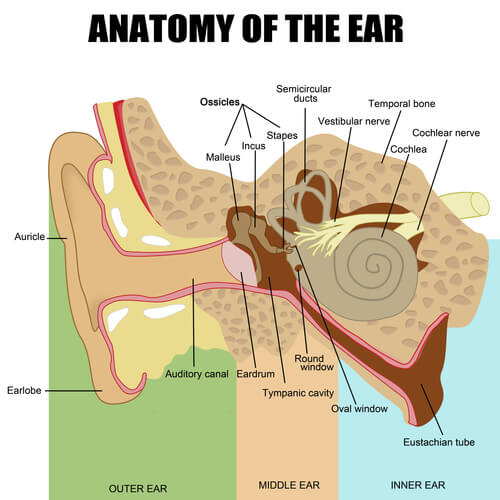In this post I will describe the anatomy and physiology of the ear, along with some of the diseases and problems which occur in the different parts.
The Anatomy Of The Ear
The ear is anatomically divided into three areas. The outer ear, the middle ear and the inner ear. The outer ear consist of the part that you can see along with the ear canal. The shell like part on the outside is called the auricle. The dangly bit at the bottom is the pinna. The auricle acts to collect the sound and channel it towards the canal in the middle. Surprisingly, the shape of the outer ear is designed to help us know the direction that sound is coming from. If the sound is coming from the left it will clearly be much louder in the left ear and so this will help us work out the direction. If the sound is directly in front of us or behind us then an equal amount will enter each ear and this will not help us work out the direction. We wouldn't be able to tell the difference.
A Beginner's Guide To Ear Anatomy And Physiology
How Can We Tell Which Direction Sound Is Coming From?
Interestingly the shape of the ear alters the sound subtly in a way which we may not be consciously aware of but is detectable by our brain. If the sound is behind us then it is altered in such a way that our brain will recognise the difference compared to when it is in front of us.
Some unusual sound recordings take advantage of the way our ears work. There are apps and music available which can make it sound as though somebody is walking around you. The sound seems to be coming from behind and in front, even though you are listing through headphones. The sound is recorded with microphones in a dummy head with realistically shaped outer ears. This means that the sound has been changed by the shape of the ear when it reaches the microphones. The sound is then recorded, including the subtle changes from the shape of the ears. When you are listening the sound appears to come from behind you when in fact it is coming from the earphones in your ears.
The Ear Canal
The ear canal is the passageway which joins the auricle of your ear on the outside to the eardrum. The eardrum marks the boundary of the outer and the middle ear. Outer ear infection is a common problem which is often called swimmer's ear. The medical name is otitis externa. Common causes include swimming, skin conditions such as eczema and scratches and abrasions on the ear which allow bugs in.
The eardrum is a very thin layer of skin, also known as the tympanic membrane. It is thin to allow it to vibrate when sound reaches it. Sound is channelled down the ear canal and vibrates the eardrum, allowing us to hear. Although the eardrum is delicate it is well protected at the end of the ear canal. This means that it is rarely damaged by direct trauma. It can, however, be harmed by indirect trauma from sudden changes in the air pressure or from an infection causing rupture.
There have been several stories shared online recently about people being found to have centipedes in their ears. Videos show them being removed from people's ear canals. Whilst asleep insects will crawl in as the canal looks like a safe, warm place to live. The first that people may be aware is when they wake up and experience pain and discomfort in the ear.
A high energy pressure wave such as that which occurs in a bomb blast causes a shear force across the drum and can result in rupture. Because it has air on both sides it vulnerable to pressure changes. A sudden increase in pressure on one side presses hard on the drum. This causes stretching and possible rupture.
The Middle Ear
Travelling inward from the outer ear, past the eardrum, we come to the middle ear. This is an air-filled space which is connected to the back of the nose by the Eustachian tube. It is the home of the ossicles. These are the smallest bones in the human body. The first ossicle is connected to the eardrum. The last is connected to the cochlea in the inner ear. When the eardrum vibrates, the movement is passed on to the chain of ossicles. The bones are connected together with tiny joints which act to amplify and transmit the vibrations to the inner ear.
The Stapes
The smallest bone in the human body is one of the ossicles. The stapes, meaning stirrup, is in the region of 3 mm long. Stapes means stirrup in Latin, it is called this because of its shape.
The middle ear is a common site of infection. If the Eustachian tube becomes blocked then the middle ear does not drain. The air in the space is replaced with fluid. This can become infected and results in middle ear infection. Chronic blockage can result in persistent fluid behind the drum. This is often called 'glue ear'. The fluid may become infected and antibiotics may be needed to get the infection under control. If the problem is recurrent then grommets may be required to replace the role of the Eustachian tube and drain the fluid.
The Inner Ear
Sound travels through the ear canal, via the eardrum and the chain of ossicles. These conduct it to the inner ear where the cochlear changes the sound energy into nerve signals. These are sent through the auditory nerve to the brain. The auditory cortex of the brain translates the nerve signals into what we perceive as sound.
The inner ear also contains the semicircular canals. These are curved and lined with sensitive hairs. The canals are filled with fluid. When you turn your head inertia means that the fluid stays relatively still. As the canals turn with your head the tiny hairs are wafted by the fluid. They send a signal to your brain. This is how you know when your head turns.
When you go round and round, such as on a roundabout, the fluid starts to spin as well. When you stop going round the fluid carries on spinning, continuing to waft the hairs. Your eyes and your body tell you that you are stationary, your semicircular canals tell you you are moving. You feel dizzy!
The inner ear also contains tiny structures called otoliths. This translates as 'ear stones'. They are like tiny pebbles which are connected at one point. When your head moves, they move, giving you information about the position of your head. Sometimes they come off and rattle about. This is usually experienced as vertigo.
Summary
The ear is anatomically divided into the outer, middle and inner ear. The outer ear consists of the auricle and canal. These collect the sound and help us know the direction it comes from. The middle ear consists of the eardrum and the ossicles which live in an air-filled space. This amplifies the sound and transmits it to the inner ear. This consists of the cochlear and the semi-circular canals. The cochlear takes the sound vibration energy and converts it to nerve signals which are transmitted to the brain.
Dr Toby Bateson for ZenPlugs.com



